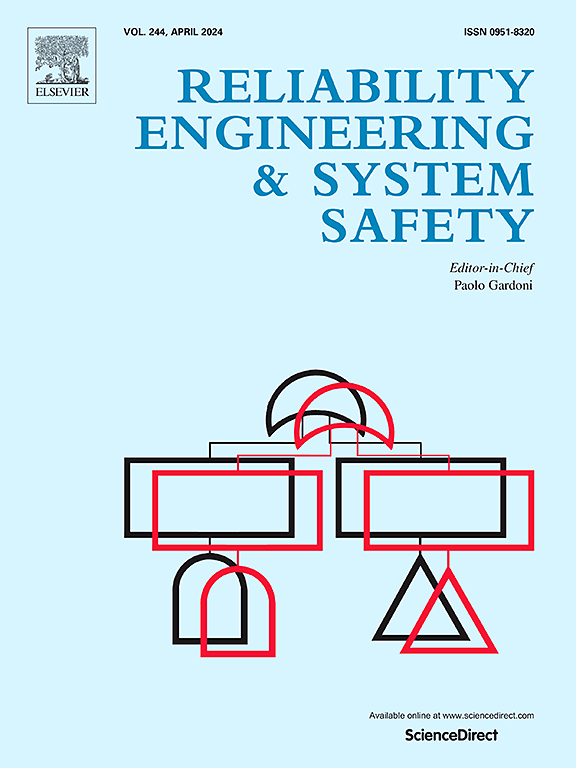A dynamic risk-informed framework for emergency human error prevention in high-risk industries: A Nuclear Power Plant case study
IF 9.4
1区 工程技术
Q1 ENGINEERING, INDUSTRIAL
引用次数: 0
Abstract
Human reliability analysis (HRA) plays a pivotal role in safety-critical systems, with its methodological evolution currently advancing into the third generation, characterized by dynamic modeling and deeper cognitive processing frameworks. In this study, we propose a novel paradigm extension to HRA, introduced within an emergent operational environment. Specifically, we develop a dynamic risk-informed framework (DRIF) that integrates Bayesian networks (BNs), long short-term memory (LSTM) neural networks, and domain-specific emergency operating procedures (EOPs) to enable real-time evaluation of human error risks during emergency scenarios. The framework employs Bayesian networks to probabilistically model causal relationships among human factors, while LSTM networks dynamically process temporal operational data streams for fault diagnosis. This hybrid architecture synergizes HRA principles with real-time risk propagation mechanisms, thereby enhancing situational awareness and decision granularity under time-critical conditions. To empirically validate DRIF’s efficacy, we implemented it in anomaly mission scenarios for a high-temperature gas-cooled reactor (HTGR). The case study demonstrates the framework’s capability to (1) quantify human error probabilities (HEPs) through probabilistic inference, (2) identify latent risk pathways via backward propagation analysis, and (3) provide prescriptive guidance aligned with EOPs for risk mitigation. The results show that the more precisely later emergency action measures are implemented, the better the accident prevention and control effect during emergencies. This advancement establishes a methodological foundation for next-generation HRA systems in complex engineered systems.
在高风险工业中预防紧急人为错误的动态风险知情框架:一个核电站案例研究
人的可靠性分析(Human reliability analysis, HRA)在安全关键系统中起着举足轻重的作用,其方法发展已进入第三代,其特点是动态建模和更深层次的认知处理框架。在这项研究中,我们提出了一个新的范例扩展到HRA,在一个紧急的操作环境中引入。具体来说,我们开发了一个动态风险通知框架(DRIF),该框架集成了贝叶斯网络(bn)、长短期记忆(LSTM)神经网络和特定领域的紧急操作程序(EOPs),以便在紧急情况下实时评估人为错误风险。该框架采用贝叶斯网络对人为因素之间的因果关系进行概率建模,而LSTM网络则动态处理时序运行数据流以进行故障诊断。这种混合体系结构将HRA原理与实时风险传播机制协同起来,从而增强了时间关键条件下的态势感知和决策粒度。为了验证DRIF的有效性,我们在高温气冷堆(HTGR)的异常任务场景中实施了DRIF。案例研究展示了该框架的能力:(1)通过概率推理量化人为错误概率(HEPs),(2)通过反向传播分析识别潜在风险路径,以及(3)提供与EOPs一致的说明性指导,以减轻风险。结果表明,应急后期行动措施实施越精确,突发事件中事故防控效果越好。这一进展为复杂工程系统中的下一代HRA系统奠定了方法学基础。
本文章由计算机程序翻译,如有差异,请以英文原文为准。
求助全文
约1分钟内获得全文
求助全文
来源期刊

Reliability Engineering & System Safety
管理科学-工程:工业
CiteScore
15.20
自引率
39.50%
发文量
621
审稿时长
67 days
期刊介绍:
Elsevier publishes Reliability Engineering & System Safety in association with the European Safety and Reliability Association and the Safety Engineering and Risk Analysis Division. The international journal is devoted to developing and applying methods to enhance the safety and reliability of complex technological systems, like nuclear power plants, chemical plants, hazardous waste facilities, space systems, offshore and maritime systems, transportation systems, constructed infrastructure, and manufacturing plants. The journal normally publishes only articles that involve the analysis of substantive problems related to the reliability of complex systems or present techniques and/or theoretical results that have a discernable relationship to the solution of such problems. An important aim is to balance academic material and practical applications.
 求助内容:
求助内容: 应助结果提醒方式:
应助结果提醒方式:


